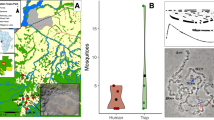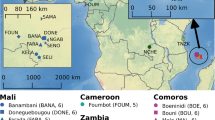Abstract
MOSQUITOES of the Anopheles gambiae complex are a closely related group of species that cannot all be distinguished easily on usual morphological grounds1,2. The complex consists of five known sibling species in Africa3,4 of which A. melas Theobald and A. merus Donitz breed in salt water, and forms provisionally known as species A, species B and species C breed in freshwater. Species C is not markedly anthropophilic1,5, but species A and B are the primary vectors of human malaria throughout much of Africa, and A. merus and A. melas are malaria vectors of lesser importance in the coastal regions of East and West Africa1,5. Individuals of the species which breeds in freshwater can only be identified with certainty by the banding patterns of their polytene chromosomes7–10.
This is a preview of subscription content, access via your institution
Access options
Subscribe to this journal
Receive 51 print issues and online access
$199.00 per year
only $3.90 per issue
Buy this article
- Purchase on Springer Link
- Instant access to full article PDF
Prices may be subject to local taxes which are calculated during checkout
Similar content being viewed by others
References
Davidson, G., Paterson, H. E., Coluzzi, M., Mason, G. F., and Micks, D. W., in Genetics of Insect Vectors of Disease (edit. by Wright, J. W., and Pal, R.) (Elsevier, Amsterdam, 1967).
Coluzzi, M., Riv. Malar., 43, 197 (1964).
Davidson, G., Riv. Malar., 43, 167 (1964).
Davidson, G., Bull. Wld Hlth Org., 31, 625 (1964).
Paterson, H. E., Paterson, J. S., and van Eeden, G. J., Med. Proc., 9, 414 (1963).
Coz, J., and Brengues, J., Med. Afric. Noire, 6, 301 (1967).
Coluzzi, M., Atti. Accad. Naz. Lincei Rc., 40, 671 (1966).
Coluzzi, M., and Sabatini, A., Parassitologia, 9, 73 (1967).
Coluzzi, M., Parassitologia, 10, 179 (1968).
Coluzzi, M., and Sabatini, A., Parassitologia, 10, 155 (1968).
Paterson, H. E., S. Afric. J. Med. Sci., 28, 33 (1963).
Ramsdale, C. D., and Leport, G. H., Bull. Wld Hlth Org., 36, 494 (1966).
White, G. B., in Annual Report of the East African Institute of Malaria and Vector-Borne Diseases (Tanzania, 1967).
Paterson, H. E., Riv. Malar., 43, 191 (1964).
Mayr, E., Animal Species and Evolution (Oxford University Press, London, 1963).
Marchal, E., Bull. Inst. Fr. Afric. Noire, Ser. A. 21, 180 (1959).
Coz, J., and Hamon, J., Riv. Malar., 43, 233 (1964).
Anderson, E., and Hubricht, L., Amer. J. Bot., 25, 396 (1938).
Dobzhansky, T., Genetics and the Origin of Species, third ed. (Columbia University Press, New York, 1951).
Author information
Authors and Affiliations
Rights and permissions
About this article
Cite this article
WHITE, G. Chromosomal Evidence for Natural Interspecific Hybridization by Mosquitoes of the Anopheles gambiae Complex. Nature 231, 184–185 (1971). https://doi.org/10.1038/231184a0
Received:
Issue Date:
DOI: https://doi.org/10.1038/231184a0
This article is cited by
-
Systematic identification of plausible pathways to potential harm via problem formulation for investigational releases of a population suppression gene drive to control the human malaria vector Anopheles gambiae in West Africa
Malaria Journal (2021)
-
The polymorphism and the geographical distribution of the knockdown resistance (kdr) of Anopheles sinensis in the Republic of Korea
Malaria Journal (2012)
-
Transmissionselektronenmikroskopie von gesteinsbildenden Mineralien
Die Naturwissenschaften (1975)
Comments
By submitting a comment you agree to abide by our Terms and Community Guidelines. If you find something abusive or that does not comply with our terms or guidelines please flag it as inappropriate.



